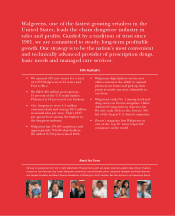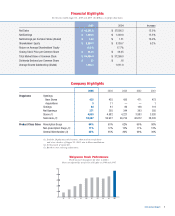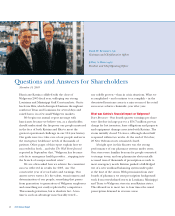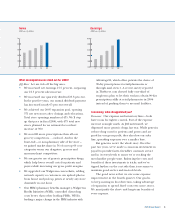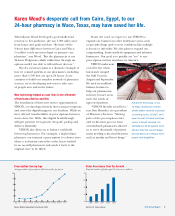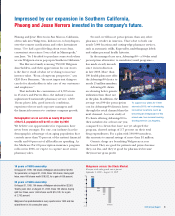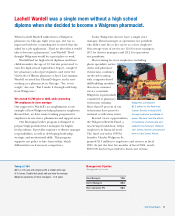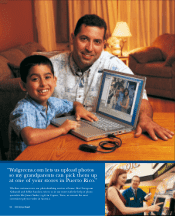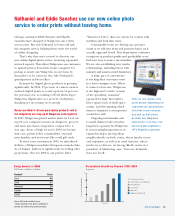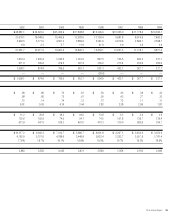Walgreens 2005 Annual Report Download - page 11
Download and view the complete annual report
Please find page 11 of the 2005 Walgreens annual report below. You can navigate through the pages in the report by either clicking on the pages listed below, or by using the keyword search tool below to find specific information within the annual report.
Impressed by our expansion in Southern California,
Phuong and Jesse Herrera invested in the company’s future.
Walgreens versus the Stock Market
Five-year stock value growth rate in percent
September 1, 2000 – August 31, 2005
10 years of WAG ownership
On August 31, 1995, 100 shares of Walgreen stock sold for $2,450.
Ten years later, on August 31, 2005, those 100 shares, having split
twice, were 400 shares worth $18,532, for a gain of 656 percent.
20 years of WAG ownership
On August 31, 1985, 100 shares of Walgreen stock sold for $2,563.
Twenty years later, on August 31, 2005, those 100 shares, having
split four times, were 1,600 shares worth $74,128, for a gain
of 2,792 percent.
Walgreens has paid dividends in every quarter since 1933 and has
raised them for 30 consecutive years.
2005 Annual Report 9
Phuong and Jesse Herrera in San Marcos, California,
often rush into Walgreens, kids in tow, to buy diapers,
over-the-counter medications and other last-minute
items. “I’ve had a good feeling about your clean,
convenient stores since I was a kid in Minneapolis,”
says Jesse. “So I decided to purchase some stock when
we saw Walgreen stores pop up in Southern California.”
The Herrera family is among 750,000 Walgreen
shareholders, and their appreciation for our stores
is the direct result of what we’re doing to increase
investor value. “From a long-term perspective,” says
CEO Dave Bernauer, “the most important thing we
can do for shareholders is take care of our customers
and employees.”
That includes the convenience of 4,953 stores
in 45 states and Puerto Rico, the industry’s most
sophisticated nationwide pharmacy service, 4,880
1-hour photo labs, good in-stock conditions,
experienced store and corporate managers and
the financial resources to continue company growth.
Demographics are on our side as nearly 20 percent
of the U.S. population will be 65 or older by 2026
We believe our opportunities for expansion have
never been stronger. For one, our industry has the
demographic advantage of an aging population that
controls more than 75 percent of the nation’s financial
wealth and 60 percent of all healthcare spending. As
the Medicare Part D prescription insurance program
rolls out in 2006, we expect to capture more senior
pharmacy sales.
Second, we fill more prescriptions than any other
pharmacy retailer in America. That’s due to both our
nearly 5,000 locations and cutting-edge pharmacy services,
such as automatic refills, ExpressPay, multi-language labels
and online personal health histories.
In the managed care area, Advantage90 – a 90-day retail
prescription alternative to mandatory mail programs –
has made steady inroads
since its introduction
in late 2003. More than
180 health plans now offer
the Advantage90 choice to
nearly 1.5 million members.
Advantage90 clients
are showing better generic
utilization than those not
in the plan. In addition, the
average total 90-day prescription
cost for Advantage90 clients is lower
through the retail channel than the
mail channel. A recent study of
25 clients offering Advantage90 to
their members for at least one year,
compared to clients that have not yet adopted the
program, showed savings of 2.7 percent on their total
drug expenditures. For a plan with 100,000 members,
this amounts to annual savings of more than $1 million.
Generic drugs are benefiting Walgreens across
the board. They are good for patients and payers because
they cost less, and they’re good for pharmacies because
they increase gross profit.
To support our plans for 7,000
stores by 2010, we’re developing
innovative locations, such as
becoming an integral part of this
mixed-use, low-income housing
development in Los Angeles.


